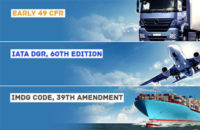It’s still a few weeks until Labor Day and the unofficial end of the season. However in strong contrast to the recent summer regulatory doldrums, as we head towards summer’s end the Federal Register was busy indeed this week with multiple large published actions by a number of relevant agencies. Grab your coffee and find…
How to get strategic about hazmat packaging efficiency
If you’re an e-commerce customer—and who isn’t these days?—you’ve probably had the experience of receiving a small item in a large package and wondering, Was this really the most efficient way to ship this thing? As a supply chain professional, however, you know the answer probably isn’t that simple. Packaging efficiency in today’s decentralized omnichannel…
Shipping lithium batteries by mail: 3 things you must know
If you’re in the hazmat business, you’re no stranger to Publication 52 from the United States Postal Service. Affectionately referred to as “Pub 52,” this public document (a.k.a. “Hazardous, Restricted, and Perishable Mail“) outlines the do’s and don’ts for the safe transport of Dangerous Goods via the U.S. mail. One of the thorniest topics in…
DOT PHMSA Lithium Battery Interim Final Rule (IFR) Effective Immediately
The long-awaited DOT PHMSA Interim Final Rule (IFR) enhancing the safety provisions for lithium batteries transported by aircraft appeared in the Federal Register this week on March 6th. This IFR generally harmonizes the 49 CFR with the ICAO Technical Instructions for the Safe Transport of Dangerous Goods by Air (regulations effective in the ICAO TI…
Hazmat pros—with HM-215O coming, how do you spell “harmonization?”
Last week we shared transatlantic viewpoints on confidence in Dangerous Goods compliance. This week, our experts talk about harmonization between Europe and North America. The supply chain is more global than it’s ever been. Yet Dangerous Goods regulations still vary from country to country. The differences in hazmat regulations between Europe and North America are—thankfully—nowhere…
Why are American hazmat pros less confident? Two experts weigh in.
Remember, back when you were in school, the feeling of walking out of a final exam knowing you absolutely nailed it? That’s how we want Dangerous Goods pros to feel about their operations every day—like they got every last detail right, and that all their outcomes will be positive. Unfortunately, that’s not the reality. Year…
DOT Departments Limit Services During Continued Government Shutdown
Have you been curious how the partial Government shutdown has affected the Department of Transportation (DOT) offices? DOT recently issued a plan document outlining how each office is operating during the current funding freeze. It includes a summary of personnel affected (working vs. furloughed), as well as summaries of continuing operations and suspended activities. Hazardous…
2018: The year in Dangerous Goods regulations
2018 was a relatively quiet year in the Dangerous Goods galaxy, with few major new regulatory changes and no unexpected surprises from domestic or international regulatory bodies. Still, as Labelmaster’s Manager of Regulatory Affairs and Corporate Responsibility, I hear all the questions from our customers and partners about how best to comply with regulations. This…
DOT introduces HazMatt to combat the “plain brown box”
Every year in the United States, there are approximately 1,500 reported transportation incidents caused by undeclared hazmat shipments. These rail fires, battery explosions and other incidents injure carrier employees and first responders while exposing them to dangerous chemicals and substances. Dangerous Goods regulations are useless if shippers don’t know what Dangerous Goods are. Ask any…
Your fall guide to 2019 Dangerous Goods regulatory publications
Who doesn’t love fall? The trees go ablaze with color, the air takes on that indescribable crispness, and the latest Dangerous Goods regulatory publications become available. (Alternate opening for those in the southern hemisphere: Who doesn’t love spring? The trees burst from grey to green, the air takes on that indescribable lushness, and the latest…









